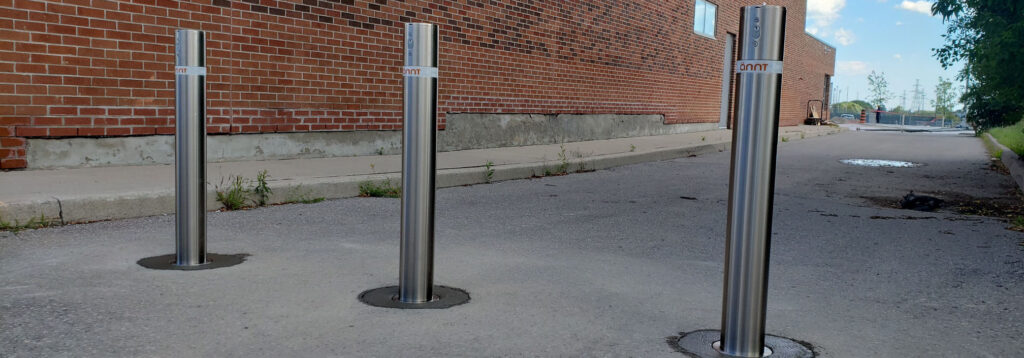Understanding The Difference: Crash-Rated vs Engineered Bollards
Perimeter security is a top priority and choosing the right protective measures for your property is crucial. Bollards, those sturdy vertical posts you see lining sidewalks and protecting buildings, play a vital role in security and traffic management. But not all bollards are created equal. In this guide, we’ll dive deep into the world of bollards, specifically comparing crash rated bollards with engineered bollards.
Understanding Bollards: The Basics
Let’s quickly recap what bollards are and why they’re important. Bollards are short, sturdy posts designed to control or direct traffic and protect pedestrians, buildings, and other assets from vehicle impacts. They come in various types, but today we’re focusing on two specific categories: crash rated bollards and engineered bollards.
Crash Rated Bollards: The Gold Standard in Security
Crash rated bollards are the heavy-hitters of the bollard world. These formidable structures are designed and tested to withstand specific impact forces from vehicles. But what exactly makes a bollard “crash rated”?
The Testing Process
To earn the “crash rated” designation, bollards undergo rigorous testing procedures. These tests simulate real-world crash scenarios, often involving vehicles of different sizes and weights colliding with the bollards at various speeds. The bollards must successfully stop the vehicle and maintain their structural integrity to pass the test.
Performance Standards
Crash rated bollards are typically evaluated according to standards set by organizations like ASTM International or the U.S. Department of State. These standards, such as the K-rating system, provide a clear measure of a bollard’s ability to withstand impacts. For example, a K12 rated bollard can stop a 15,000-pound vehicle traveling at 50 mph.
Applications of Crash Rated Bollards
Due to their proven performance, crash rated bollards are often deployed in high-security areas such as:
- Government buildings
- Military installations
- Airports
- Critical infrastructure sites
- High-profile public spaces
Engineered Bollards: Customized Solutions for Varied Needs
While crash rated bollards offer top-tier security, engineered bollards provide a more flexible solution for a wider range of applications. But what exactly are engineered bollards?
The Design Process
Unlike crash rated bollards, which are designed and tested to meet specific impact resistance standards, engineered bollards are custom-designed for particular sites and purposes.
Engineers consider factors such as:
- Expected traffic patterns
- Potential impact forces
- Soil conditions
- Aesthetic requirements
This tailored approach allows for greater versatility in design and application.
Customization Options
One of the key advantages of engineered bollards is the level of customization available. They can be designed to complement the architectural style of their surroundings, incorporate lighting elements, or even serve dual purposes like bicycle parking.
Applications of Engineered Bollards
Engineered bollards find use in a variety of settings, including:
- Urban streetscapes
- Parking lots
- Retail environments
- Residential areas
- Parks and recreational spaces
Key Differences: Crash Rated vs. Engineered Bollards
Now that we’ve explored both types, let’s highlight the key differences between crash rated and engineered bollards:
- Testing and Certification
The most significant difference lies in the testing and certification process. Crash rated bollards undergo standardized impact tests and receive official ratings, while engineered bollards are designed based on calculated performance expectations but aren’t necessarily tested to the same rigorous standards.
- Design Flexibility
Engineered bollards offer greater design flexibility. They can be customized to meet specific aesthetic requirements or serve multiple functions. Crash-rated bollards, while sometimes available in different finishes and customizable with lights and other accessories, are primarily designed for maximum impact resistance.
- Cost Considerations
Generally, crash-rated bollards are more expensive due to the extensive testing and certification process they undergo. Engineered bollards can often be more cost-effective, especially for applications that don’t require the highest level of impact resistance.
- Installation Requirements
Crash-rated bollards typically have more stringent installation requirements to ensure they perform as tested. This often involves deep foundations and reinforced concrete. Engineered bollards may have more flexible installation options depending on their intended use.
- Performance Guarantees
Crash-rated bollards come with specific performance guarantees based on their ratings. While engineered bollards are designed to meet certain performance criteria, they may not come with the same level of guaranteed impact resistance.
Choosing Between Crash-Rated and Engineered Bollards
Selecting the right type of bollard depends on several factors:
- Site-Specific Considerations
Assess the location where the bollards will be installed. High-security areas or locations at risk of vehicle attacks may require crash-rated bollards, while lower-risk areas might be adequately served by engineered bollards.
- Security Requirements
Determine the level of security needed. If you require guaranteed protection against high-speed, heavy vehicle impacts, crash-rated bollards are the way to go. For general traffic management or lower-level security, engineered bollards may suffice.
- Budget Constraints
Consider your budget. If cost is a significant factor and your security needs aren’t at the highest level, engineered bollards might be more appropriate.
- Aesthetic Preferences
If the visual appeal of the bollards is important, engineered bollards offer more design flexibility. However, some crash rated bollards are also available in decorative options.
Making the Right Choice
In the world of bollards, both crash-rated and engineered options have their place. Crash-rated bollards offer unparalleled security and impact resistance, backed by rigorous testing and certification. They’re the go-to choice for high-security applications where vehicle attacks are a real concern.
Engineered bollards, on the other hand, provide a more flexible and often more cost-effective solution for a wide range of applications. They can be tailored to meet specific site requirements and aesthetic preferences, making them suitable for many urban and commercial environments.
Ultimately, the choice between crash-rated and engineered bollards depends on your specific needs, security requirements, and budget considerations. By understanding the key differences between these two types of bollards, you can make an informed decision that ensures the safety and security of your property while meeting your aesthetic and functional requirements.
Remember, whether you opt for the proven impact resistance of crash rated bollards or the versatility of engineered bollards, you’re taking a crucial step in protecting your assets and enhancing safety in your environment.



